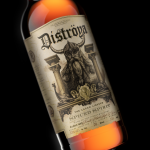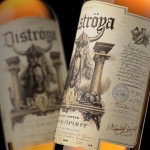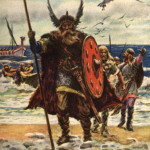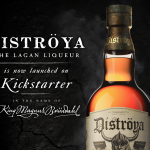King Magnus is set to conquer the shooter market

Diströya Spirits, Inc. is focused on building a trilogy of unique spirit flavors, each with it’s own story. First up: “The Dragon’s Share,” based on a mythological and fun story of a spiced spirit created by the Viking King Magnus.
A recent article in Epicurious, had this to say: “The Vikings might have bludgeoned you on the head with a club, but Diströya, a Viking-based 70-proof spirit, takes a rather more mellow approach when it assaults your senses.”
The back-story
I met the owner of Diströya Spirits a few years ago. He was (and still is) a reader and follower of this blog and contacted me for some advice about the product he planned to launch. I get these types of calls and emails very often but, this time, it felt different. Scott Raynor, the owner, is an impressive guy. He’s a musician (when he has time to work that craft), an ex-bartender and among the most tenacious and innovative booze business entrepreneurs I’ve met. He has a vision and the patience to see it through. (Disclosure: I continue to be a non-paid advisor to Scott.)
The product
According to Scott, Diströya has less sugar and a lot more mystery than other liqueurs, uh, shooters. “There’s blood orange on the nose and entry, rounded out with vanilla, almond and cinnamon in the middle, finishing with the crispness of ginger and citrus,” he explains. “It’s lighter than a lot of liqueurs, and not cloying.”

While he describes his product as a liqueur, which is its official TTB classification, such a booze product by any other name is still a shooter. In fact, he cites his competitive set as Jägermeister, Fireball, Kraken and others. But, Scott is savvy enough not to put his fledgling brand in a box and reports that bartenders are using it in mojitos, as a Ginger Viking (a Moscow Mule) and in other cocktails. It sells for $19.99 for a 750ML.
I’m well past the shooter stage and have a limited repertoire of cocktail preferences, so I enjoy it on the rocks. It’s pleasant tasting, smooth and makes me want to plunder and pillage. It’s all that Scott says it is.
The people
Despite the absence of meaningful resources, Scott’s contagious enthusiasm, industry knowledge (self taught) and likeability, has attracted an all-star team of spirits industry mavens in sales and marketing. Add to that some outstanding designers and illustrators. In particular, he worked with

Chad Michael, a gifted designer who recently opened his own studio after working for a well known design firm. Also involved was Steven Noble, the illustrator for Kraken rum and Espolon tequila who collaborated in rendering the King Magnus icon.
He’s managed to do, on a shoestring budget, what the big spirits boys cannot do – form a team, launch a product and build a brand. And, he’s doing it the hard way.
What’s happening now?
Diströya is currently independently distributed in Denver. They are meeting with major distributors in the fall and expects to secure one. The brand is definitely getting traction in bars and stores. But, as is the case with nearly all indie startups, money is an issue.
So what does an enterprising new breed spirits maker do? Scott is going the conventional route of looking for investors, with some success I might add. But, in addition, he’s using crowd sourcing and has launched a Kickstarter campaign. You can find it here. Check it out, for a few bucks, one day you’ll be able to say you invested in Diströya Spirits.
What I think is particularly brilliant about the Kickstarter campaign is that at the same time as he is raising some money, he is building awareness.
Did I mention that he’s smart?
Come on… contribute a few bucks.

